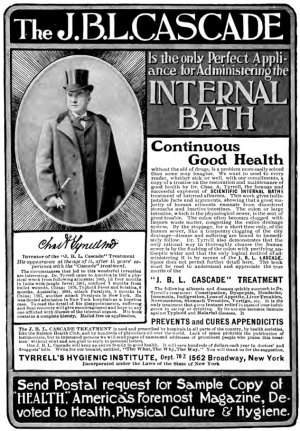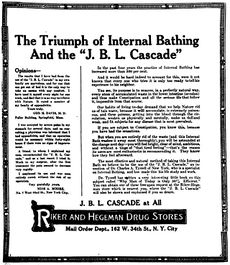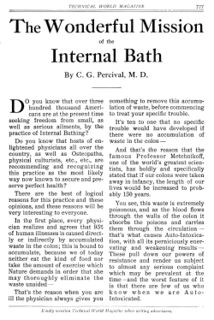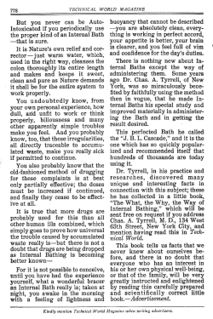Tyrrell's Hygienic Institute
From Kook Science
Tyrrell's Hygienic Institute, Inc. was a supplier of hygiene products and publisher based in New York. Established in 1894 by Charles Alfred Tyrrell, it engaged in regular nation-wide advertising campaigns in U.S. newspapers, promoting products like the J.B.L. Cascade, the company's specialty enema kit, as curatives for a variety of afflictions attributed to colonic uncleanliness.
Products
- The main product was the J.B.L. (Joy - Beauty - Life) Cascade, an enema bag with a rectal syringe on to the top, allowing the water to be pushed into the user's rectum by sitting on it, as opposed to having it flow down through a tube.
- The J.B.L. Antiseptic Tonic, a solution for rendering water for the enema "completely sterile unless [the water] be notoriously impure."
- Dr. Tyrrell's Health Soap, described as "free from any deleterious substance," and "a perfect antiseptic and healing soap."
Selected Publications
- "The Royal Road to Health, or The Secret of Health Without Drugs", first printed in 1894, with hundreds of re-editions and revised editions published in decades thereafter, as late as 1946. First editions are credited to Charles Alfred Tyrrell; later editions, published as "The Royal Road" are credited to E.J. Borzilleri, who re-wrote and expanded it in the 1930s.
- Alcinous B. Jamison, "Intestinal Ills: Chronic Constipation, Indigestion, Autogenetic Poisons, Diarrhea, Piles, Etc. Also Auto-Infection, Auto-Intoxication, Anemia, Emaciation, Etc. Due to Proctitis and Colitis" (c. 1901)
Selected Patents
- Henry M. Guild's "Rectal Syringe", assigned to Tyrrell's Hygienic Inst., patented on 9 June 1903 under US Patent No. 730822, described as relating "to the class of syringes used for irrigating the rectum, also for flushing the colon. The device is so constructed that when the stem is entered into the anus the sphincter muscle, closing on the conoidal-shaped head, keeps the stem central in the rectum, thereby avoiding any injury to the walls of the rectum by undue lateral pressure."
- Alfred C. Egger's "Rectal Syringe", assigned to Charles A. Tyrrell, patented on 24 February 1914 under US Patent No. 1087935, which is a water-bottle based design.
- Charles A. Tyrrell's "Rectal Syringe", patented on August 1915 under US Patent No. 1155848, described as "an improved nozzle or 'injection point' for rectal syringes", being comprised of an exterior of soft rubber over a hard rubber member, designed for stationary use "on a recumbent water-bottle or bag."



